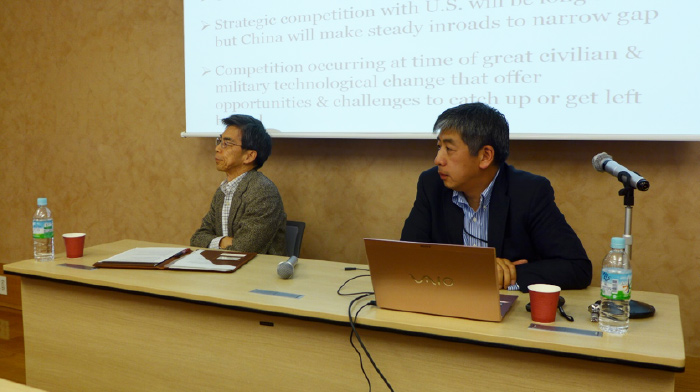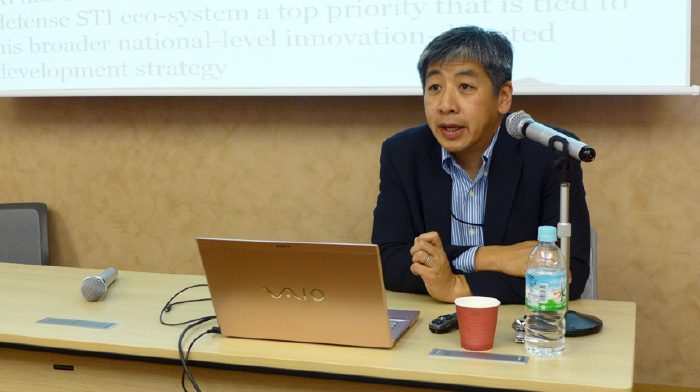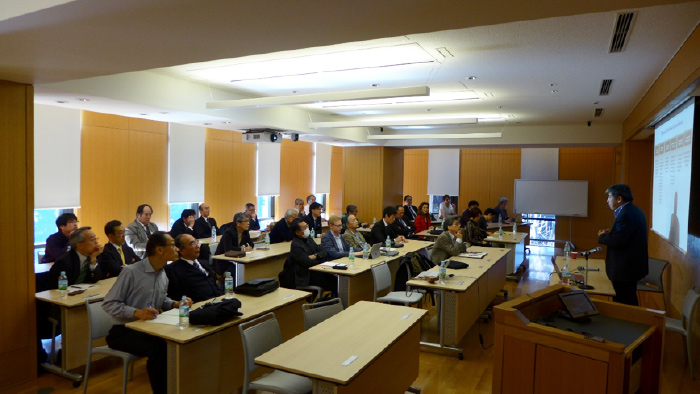SSU Forum with Professor Tai Ming Cheung
| Date: | Wednesday, February 15 2017, 10:30-12:00 |
|---|---|
| Venue: | Seminar Room, 3rd Floor, Ito International Research Center |
| Subject | Understanding China’s Military Technological Rise and the Global Implications |
| Lecture: | Professor Tai Ming Cheung, University of California, San Diego |
| Language: | English |
| Hosted by: | Security Studies Unit, Policy Alternatives Research Institute, the University of Tokyo |
The Security Studies Unit was glad to host a talk delivered by Tai Ming Cheung, an associate professor specializing on international security studies at the University of California San Diego and Director of the UC Institute on Global Conflict and Cooperation.
Professor Masahiro Kohara, member of the SSU, introduced the speaker as a prominent expert on Chinese military affairs as well as on security theory. He remarked that this talk is very timely given the changing strategic environment in East Asia, particularly with a new US President in the White House.

Professor Cheung thanked the host, and introduced the topic of his talk as the examination of one of the most important dynamics taking place today in the international security system: China’s military rise, and especially its emergence as a capable technological power. A number of sub-questions are related to this, namely, the investigation of the link between industry, innovation, and the defence establishment in China, the sustainability of this change, and international implications.

In the 1990s, China’s military technology capabilities could be considered as backward, but since then the country has made very impressive progress. From being two-three generations behind it is now perhaps only around one generation behind parity with the global leaders, i.e. approximately 10 years behind the most advanced technologies in the field. How was this catch up possible in the first place? Indeed there are very few cases in history where countries, especially great powers, have been able to perform this kind of transformation. As China became stronger in military terms, the Chinese government started to its growing military might to do things which were not previously possible, particularly in terms of power projection in the South China Sea. This has also led to the re-organisation of the country’s military doctrine and armed forces in the past few years.
Understanding the change in China’s military and technological organisations requires a multi-disciplinary approach, particularly if one intends to explain the driving factors of innovation. Professor Cheung started his analysis of technological innovation of China’s military by quoting from China’s President Xi Jinping, who is acutely aware of the role of technological change in defence and the need for China to act on this front. There is certainly strong pressure from Beijing’s supreme leadership to achieve higher levels of innovation and military might. This is increasingly tied to a general strategy for the next steps in industrial and economic development, where it is expected that China, which currently absorbs innovation from foreign countries, largely by means of reverse engineering and improvement on imported designs, will become an innovation leader within the next two to three decades. In that sense, Professor Cheung argued, China is now in a transitional phase like Japan in the 1970s-1980s, when it switched from a net technology importer to a top technology exporter. China’s transformation into an innovation powerhouse is however far from being a certainty, but it appears also necessary in order to sustain economic growth in the future.

Taking about innovation drivers, Professor Cheung listed numerous factors, which can ultimately be grouped into the following categories: Catalytic, Inputs, Processes, Institutional, and Outputs. He then proceeded to analyse them more in detail, highlighting how some of the most important factors belong to the catalytic category, without which there would be no high-end innovation. Of particular importance is leadership engagement and the threat environment. Leadership engagement means, as illustrated above, that innovation speeds up and gains resources for its success if the political leadership sees it as a priority and it is committed to its advancement; this is clearly the case under Xi Jinping. Leadership is crucial in the Chinese one-party, top-down, authoritarian system to overcome bureaucratic fragmentation.
The threat environment is the perception by the Chinese leadership that the country needs technological innovation in order to counter strategic threats. As China sees other global competitors, particularly the US, transforming their militaries and acquiring new capabilities, it can also interpret this as a shift in global affairs which needs to be taken into account. There seems to be a historical correlation between the heightening of perceived threats to China and the effort in defence innovation pursued by Beijing.
Coming back to the trajectory of innovation in China with relation to military technologies, Professor Cheung stated that in the military field, China is still largely in a stage of acquiring foreign technologies, but it plans to achieve in the long term original innovation through intermediate steps like integrated innovation. Moving towards original innovation would require a shift from reverse engineering to basic scientific research.
Another important point is the future of integration between the civil and military sectors, especially concerning manufacturing and dual use industries. President Xi appears to be very proactive on this front, and the “Made in China 2025” advanced manufacturing strategy contains elements going in this direction. While China has already covered a lot of ground in the past twenty years, it is likely that the country finds itself on the verge of an even greater technological advancement over the next few years.
In conclusion, Professor Cheung addressed the problem of China’s changing political-ideological perception, as it transforms itself from a developmental state, almost exclusively focused on economic growth and infrastructure build-up, into a national security state, where the national priority will change to geostrategic competition. This will also entail a change from a win-win approach in international affairs to a more neo-realist win-lose approach of relative gains. Finally, despite the emergence of a direct Sino-US technological competition, Professor Cheung stated that the chances of a direct military conflict remain quite limited at the moment and for the foreseeable future.

